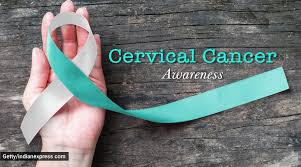Human Papillomavirus (HPV)

- 16 Jan 2025
In News:
January is Cervical Cancer Awareness Month, and the focus on this month underscores the critical importance of preventing cervical cancer, a disease responsible for significant mortality among women in India. At the heart of this prevention is the Human Papillomavirus (HPV) vaccine, which is recognized as the most effective measure to prevent cervical cancer and other HPV-related cancers. Despite its potential, the HPV vaccine remains out of reach for many due to its high cost and the need for greater awareness.
HPV and its Impact in India
HPV is responsible for 99.7% of cervical cancers worldwide, making it one of the primary causes of cancer in women. In India, cervical cancer is the third most common cancer among women, accounting for about 6-29% of all cancers in women. As of GLOBOCAN 2020, India alone has 20% of the global burden of cervical cancer, with over 123,000 cases and a 9.1% mortality rate.
Additionally, HPV can lead to several other cancers, including anal, vulvar, vaginal, penile, and throat cancers, making its vaccination vital for overall cancer prevention.
The HPV Vaccine: A Game-Changer
The HPV vaccine is the most effective tool to prevent infections caused by the virus and reduce the incidence of associated cancers. The vaccine works by stimulating the immune system to produce antibodies that neutralize the virus before it can cause damage. There are different types of vaccines authorized in India, including:
- Gardasil (protects against HPV types 6, 11, 16, and 18)
- Cervarix (a bivalent vaccine targeting HPV 16 and 18)
- Cervavac (India's first HPV vaccine, developed by the Serum Institute of India)
The vaccine is recommended for both males and females between 9 and 26 years, with a special focus on children aged 12 to 13 years, as the vaccine is most effective when administered before exposure to the virus. It’s also suitable for people who are immunocompromised or HIV-infected.
Challenges to HPV Vaccination in India
Despite the obvious benefits, the uptake of the HPV vaccine in India faces several barriers:
- High Costs: The price of the vaccine remains prohibitively high. For example:
- Gardasil 9 costs ?10,850 per dose.
- Gardasil 4 is priced between ?2,000 to ?4,000 per dose.
- Cervavac, the Indian-made vaccine, costs around ?2,000 per dose, which is more affordable but still out of reach for many.
- Awareness and Cultural Perceptions: There is a lack of awareness about HPV and its link to cervical cancer. Cultural factors, particularly around reproductive health, can also create reluctance to vaccinate, especially in rural or conservative areas.
- Limited Access: Currently, the vaccine is available through private practitioners and is not part of the National Immunisation Programme (NIP), limiting access to the broader population.
The Way Forward: National Immunisation and Awareness Campaigns
The National Technical Advisory Group on Immunisation (NTAGI) has recommended that the HPV vaccine be included in India’s National Immunisation Programme (NIP). This would enable broader access and affordability, especially for girls aged 9–14 years and ensure that a routine vaccination schedule is implemented at the age of 9 years. Some states like Punjab and Sikkim have already taken steps to introduce the vaccine in their state-level immunization programs.
Additionally, a nationwide HPV vaccination campaign could raise awareness about the vaccine and its benefits, helping to overcome the challenges of cost, safety concerns, and cultural perceptions. Regular cervical cancer screenings (such as Pap smears and HPV tests) should also be encouraged to identify precancerous changes early.
